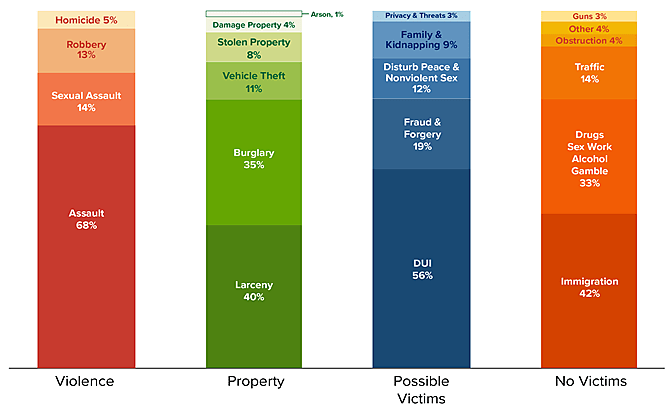Immigration and Customs Enforcement (ICE) has for years worked tirelessly to portray its duties as working to protect Americans from criminals. Yet from 2009 to February 2017, only about half of ICE’s removals were of people who had committed any crime at all. Even of those who committed a crime, the most serious offense for 60 percent of them was a victimless crime—most commonly an immigration offense, traffic infraction, or vice crimes like illicit drugs.
This post relies on ICE data published in response to a Freedom of Information Act request and now available online. The data breaks down all ICE removals from 2009 to February 2017 by the most serious criminal conviction committed by the immigrant. The criminal categories are broad, but the general trend is clear: ICE primarily removed criminals who committed crimes without a private victim (i.e. not the government or “society”). Just 12 percent committed violent crimes—and just 0.6 percent were convicted of murder. In addition, as Figure 1 shows, 47.7 percent of those ICE removed had no criminal conviction at all.
Figure 1: Immigrants Removed by ICE by Criminal Conviction, FY 2009-FY2017*
Source: Immigration and Customs Enforcement; *Through February 2017
In addition to immigrants that it arrests in the interior of the United States, ICE handles removals of some immigrants—primarily Central Americans—who were originally apprehended by Border Patrol. Roughly half of all removals during this time originated at the border. Most of the removals of noncriminals come from these referrals. But even after taking out these border apprehensions, nearly a quarter of all removals from the interior during that time still had no criminal conviction.
Figure 2 depicts the distribution of convicted immigrants within the four categories—violent crimes, property crimes, crimes with possible victims, and crimes without victims. As I have explained before, most violent crimes were assaults, which include simple assaults defined by the FBI to include assaults “where no weapon was used or no serious or aggravated injury resulted” and include “stalking, intimidation, coercion, and hazing” where no injuries occurred. The FBI excludes simple assault from its definition of violent crime, but ICE fails to break down this category, so we cannot.
Figure 2: Immigrants Removed by ICE by Criminal Conviction, FY 2009-FY2017*
Source: Immigration and Customs Enforcement; *Through February 2017
The plurality of property crimes were larcenies, which include “thefts of bicycles, motor vehicle parts and accessories, shoplifting, pocket-picking, or the stealing of any property or article that is not taken by force and violence or by fraud.”
DUIs made up the majority of the “possible victims” category. ICE data on removals fail to separate DUIs from other less significant traffic offenses. In order to do so, I used the share of traffic offenses that were DUIs among immigrants arrested by ICE in 2017. The “possible victims” category also includes some nebulous categories like “privacy,” “threats,” and disturbing the peace, which are undefined in the ICE report. Nonviolent sex crimes include statutory rape as well as lewd behaviors in public. Fraud and forgery could have victims or they could be crimes where immigrants allow their family members to use their identities to obtain work in the United States.
Family offenses include “nonviolent acts by a family member (or legal guardian) that threaten the physical, mental, or economic well-being or morals of another family member” that aren’t classified elsewhere (e.g. violating a restraining order). Kidnapping convictions generally arise from custody disputes between parents over children, so I included them in this category.
Victimless offenses were traffic infractions that were not DUIs, immigration offenses such as entering the country illegally, or “vice” crimes (drugs, sex work, or alcohol). Immigration “crimes” include illegally entering the country, reentering after a deportation, falsely claiming U.S. citizenship, and smuggling. Obstruction offenses mainly include parole and probation violations or failure to appear in court. They also include “general crimes” mainly comprising conspiracy offenses and money laundering related crimes.
ICE should deport criminals who threaten Americans, but when it strays into removing people who are contributing to America’s economy and society, it treads on our freedom of association and harms the country. ICE needs to have its priorities redirected toward keeping America safe from criminals whose offenses actually have victims and not those who are simply seeking a better life here.

